ليس هناك شك في أن طريقة تعاملك مع عملية تأهيل الموظفين يمكن أن تنجح أو تفسد تجربتهم. فهي تمهد الطريق أمامهم للمضي قدماً.
ضع نفسك مكان الموظف الجديد لدقيقة. 👀
لقد قمت للتو ببحث مكثف عن وظيفة وخضعت لجولات من المقابلات لإثبات أنك الأنسب. بعد تقديم المراجع، والتحقق من الخلفية، ومناقشات التعويضات، والعديد من المقابلات، حصلت أخيراً على الوظيفة! 🎉
بعيون متألقة ومتحمسة للبدء، تحضر إلى دورة توجيه الموظفين الجدد لتجد نفسك أخيراً مقابلة الفريق ونطاق المكتب الجديد. ولكن ما تحصل عليه بدلاً من ذلك هو كومة من الأعمال الورقية، ومقاطع فيديو قديمة للشركة، وقائمة طويلة من المهام الإدارية التي يجب القيام بها دون تعليمات حول كيفية المضي قدماً أو من الذي يجب أن تذهب إليه للحصول على إجابات.
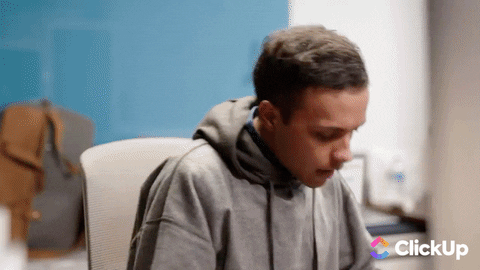
لقد مررنا جميعًا بشيء من هذا القبيل أو نعرف شخصًا ما مرّ به. في الحقيقة 88% من المنظمات فشلت في تلبية توقعات موظفيها الجدد خلال عملية التأهيل. ويتسبب ذلك في تأثير سلبي على مشاعر الموظفين وأدائهم وإنتاجيتهم.
إذا كنت محترفاً في مجال الموارد البشرية أو لديك القدرة على إجراء التغييرات، يمكنك اتخاذ الخطوات اللازمة لإنشاء برنامج تأهيل أكثر تأثيراً يترك انطباعاً دائماً بعد الأسابيع القليلة الأولى. 🙌
نحن هنا لنعرض لك أمثلة على برنامج تأهيل الموظفين ونعلمك كيفية استخدام أدوات التأهيل لتبسيط برنامجك وتتبعه وتنفيذه. فيما يلي 12 مثالاً واقعيًا على تأهيل الموظفين من محترفين في مختلف المجالات، بما في ذلك فريق ClickUp الخاص بنا!
ما أهمية تأهيل الموظفين؟
تسمح عمليات تأهيل الموظفين للشركات بمشاركة فلسفاتها، وقيمها، ورسالتها، ومسار العمل. إنها فترة حاسمة لنمو ومستقبل كل من الشركة والموظفين الجدد، حيث يتعرف الموظفون الجدد في هذه الفترة على المزيد عن المؤسسة وكيف يمكنهم المساهمة في نجاحها وتصور مستقبلهم مع الشركة، مما يمنحهم خارطة طريق ليتبعوها طوال رحلتهم.

عبر أخذ عينات الموارد البشرية
يمكن أن تضمن برامج تأهيل الموظفين الجدد المنظمة جيدًا والوظيفية والجذابة التوافق بين المنظمة والموظفين الجدد، وبالتالي تحسين معدل الاحتفاظ بالموظفين بنسبة 82%، وزيادة الإنتاجية بنسبة تزيد عن 70%، وزيادة استعداد أعضاء الفريق لإحالة الشركة إلى مرشحين آخرين بنسبة 93%.
📌بالمختصر المفيد- في عالم اليوم، حيث يقدّر الموظفون قيمة التوافق والتوافق الثقافي أكثر من أي وقت مضى، فإن برنامج التأهيل الفعال والشخصي والجذاب هو أحد أهم مؤشرات ثقافة شركتك وهو ضروري لجذب أفضل المواهب والاحتفاظ بها وكسب قلوب أفضل المواهب لديك
ما يجب مراعاته عند تصميم برنامج تأهيل الموظفين
لا يجب أن تكون استراتيجية التهيئة الفعالة معقدة - بل يجب أن تكون مقصودة ومنهجية ومليئة بالتخصيص. ففي نهاية المطاف، هذه هي فرصة شركتك للترحيب بالموظفين الجدد في عالمك. إنها فرصة لتظهر لهم ما يمكنك تقديمه كشركة وكيف يمكنكم العمل والنمو معًا. 🌱
تبدأ قيادة برنامج فعال لتأهيل الموظفين الجدد بالتدقيق الداخلي. ابدأ بتقييم عملياتك الحالية، وفهم ثقافة وقيم العمل في شركتك، ومواءمة أهداف مؤسستك مع أهداف التوظيف والموارد البشرية. 🎯
5 أسئلة لفريق الموارد البشرية لديك عند تقييم العمليات الحالية
**1. _هل تتماشى عملية وممارسات تأهيل الموظفين الحالية مع قيم الشركة الحالية؟ هل هي مصممة خصيصًا للموظفين مع وضع نموهم الوظيفي ورضاهم الوظيفي في الاعتبار؟
📌 لماذا هذا مهم: أكثر من 56% من المواهب أنهم لن يفكروا في العمل في شركة ما إذا كانت قيمهم لا تتوافق مع قيم الشركة، وكشف حوالي 46% من الموظفين في الولايات المتحدة والمملكة المتحدة أنهم يفكرون في ترك صاحب العمل الحالي بسبب عدم توافق القيم.
**2. _ هل لديك أي ملاحظات من موظفيك السابقين والحاليين لمراجعتها؟
📌 لماذا يهم ذلك: التغذية الراجعة ضرورية لنجاح عملية التأهيل، حيث ستعطي التغذية الراجعة الصادقة من الموظفين المزيد من المعلومات حول المجالات التي يمكن العمل عليها وتعديلها حتى تتمكن من تحسين تجربة موظفيك باستمرار.
**3. ما هي نقاط القوة ونقاط الضعف والفرص والتهديدات (SWOT) في برنامجك الحالي _الإعداد؟
📌 📌لماذا يهمك: قم بإجراء تحليل SWOT لمساعدة مؤسستك على تحديد كل مجال. وفي المقابل، سوف تكتشف الرؤى التي تحتاجها لتعديل نهجك بشكل صحيح، بالإضافة إلى ابتكار أفكار جديدة لتحسين تجربة الموظفين بشكل عام ووضع المزيد من المبادرات والأهداف ذات القيمة العالية.
تعرف على المزيد حول تحليل SWOT واطلع على مثال لمساعدتك على البدء هنا .
**4. هل لدى فريق الموارد البشرية لديك إجراءات تشغيل موحدة (SOP) تحدد بالتفصيل عملية تأهيل الموظفين لديك؟ _
📌 📌لماذا هذا مهم: يمكن أن يساعد وجود قواعد وإجراءات محددة بوضوح وموثقة ويمكن الوصول إليها بسهولة لفريقك والموظفين الجدد في توحيد العمليات، وتقليل منحنى التعلم ووقت التدريب، وخلق التوافق بين الموظفين الجدد وأصحاب العمل.
⭐️ نصيحة احترافية: قم بإعداد إجراءات التشغيل الموحدة للموارد البشرية الخاصة بك، على الفور. هذه قالب السبورة البيضاء لإجراءات التشغيل الموحدة للموارد البشرية سيساعدك على تنظيم وإنشاء مهام الموارد البشرية الخاصة بك والتأكد من أن موظفيك متوافقون مع إجراءات شركتك. تنزيل نموذج إجراءات التشغيل الموحدة للموارد البشرية من ClickUp 5. _ما هي الأهداف الحالية لمؤسستك من 30-60-90 لبرنامج تأهيل الموظفين؟
📌 📌لماذا يهم ذلك: بمجرد أن تلقي نظرة شاملة على عملية التأهيل الحالية في مؤسستك، اختر مجالًا من مجالات الفرص وحدد أهدافًا مركزة وذات صلة. استخدم الأهداف الذكية لتعيين مؤشرات الأداء الرئيسية والمقاييس الخاصة بالموارد البشرية. وضع خطة من 30-60-90 يومًا لفرق الموارد البشرية وفرق تطوير المواهب لديك يساعد على رسم الأهداف وتحديدها بوضوح ومواءمتها. يوفر هذا أيضًا للجميع مراجعة منتظمة حتى يكون من الأسهل إبقاء الموظفين الجدد على وتيرة واحدة ومعرفة مدى كفاءة برنامج التهيئة الخاص بك.
البحث عن
_مراجع/ https://clickup.com/blog/kpi-examples// أمثلة_KPI *%مراجع/_
لفريق الموارد البشرية لديك؟ توضح هذه المقالة تفاصيل 10 مؤشرات أداء ومقاييس رئيسية للموارد البشرية تحتاجها وكيفية تتبعها. بمجرد أن تصبح جاهزًا لتوثيقها رسميًا، قم بتطبيق مؤشرات الأداء الرئيسية الجاهزة للاستخدام
href/ https://clickup.com/templates/smart-goals-t-222168692 _نموذج أهداف SMART للأهداف الذكية %/%href/
للحصول على نظام منظم لوضع أهدافك وتتبعها في ClickUp. قم بتنزيل قالب الأهداف الذكية من ClickUp بمجرد الانتهاء من التدقيق الداخلي الخاص بك، حان الوقت لوضع استراتيجية والبدء في التخطيط لكيفية إنشاء أفضل عملية تأهيل للموظفين!
لقد قمنا بتجميع 12 مثالًا وأفكارًا واقعية حول تأهيل الموظفين حتى تتمكن من معرفة ما يمكن دمجه لجعل برنامجك التدريبي أكثر تأثيرًا وتأثيرًا. ✨
12 مثالاً من الحياة الواقعية لممارسات تأهيل الموظفين
لقد طلبنا من الرؤساء التنفيذيين ومديري شؤون الموظفين وقادة الشركات رؤاهم حول أفضل ممارسات تأهيل الموظفين و الترحيب بالموظفين الجدد . من خطابات الترحيب المكتوبة بخط اليد إلى مجموعات الترحيب، قد تلهمك هذه الأمثلة الواقعية للترحيب بالموظفين الجدد لتحسين التجربة العامة للموظفين الجدد.
مكافأة:
_/مرجع/ https://clickup.com/blog/interview-templates// قوالب المقابلات %/%href/_
مثال 1: توفير مواد التدريب وتعيين مرشد قبل تاريخ البدء
الفوائد
- يساعد الموظفين الجدد على الاستعداد ليومهم الأول
- يتيح المزيد من الوقت لاستيعاب المعلومات الجديدة قبل بدء فترة التوجيه الرسمي
- يتيح لأعضاء الفريق الجدد فرصة لمراجعة المواد والوثائق وجمع الأسئلة معًا لطرحها أثناء فترة التوجيه
- وجود مرشد معين يمنح الموظفين الجدد مورداً آخر للأسئلة ويساعدهم على الشعور بالدعم وتعلم المعلومات الخاصة بالدور بشكل أكثر فعالية
كيف يقوم الآخرون بذلك
إن وجود مرشد يمكن لأعضاء الفريق الجدد طرح الأسئلة الأساسية حول ثقافة مؤسستنا أو سلسلة الاتصالات أو حتى إيقاع العمل اليومي يساعد على إعداد الموظفين الجدد للاندماج في روتين جديد تدريجيًا
< > _ هذا يساعد على تقليل الارتباك والقلق، مما يسمح لنا بتكوين فكرة أفضل بكثير عن مهارات الموظف الجديد وتقدمه بمجرد بدء التهيئة الحقيقية

فولوديمير ششيغل كلاريو
مثال 2: إرسال هدية مجموعة أدوات الترحيب
الفوائد
- يساعد الموظفين الجدد على الشعور بالاندماج والتقدير، وأنهم جزء من الفريق
- يقلل من شعورالقلق من الوظيفة الجديدة
- أعني ... من الذي لا يحب تلقي الهدايا؟
كيف يفعلها الآخرون
_مجموعات الترحيب ضرورية! فهي تتيح للموظفين الجدد أن يشعروا بالإثارة والحماسة ويشعروا بالتميز والراحة عند دخولهم في دورهم
نسمح لهم بطلب صناديق الهدايا الخاصة بهم، والتي تتكون من قمصان وسترات وجوارب وملصقات وأجهزة AirPods ذات علامة تجارية. كما نرسل لهم أيضاً دليل البقاء على قيد الحياة لليوم الأول عبر البريد الإلكتروني يوضح كل ما يجب أن يتوقعوه حتى يومهم الأول
_ كل هذا معًا يخلق مساحة آمنة للحد من قلقهم في اليوم الأول، مما يجعلهم يشعرون بأنهم مستعدون وجاهزون

كاثرين ريكيا
انقر فوق
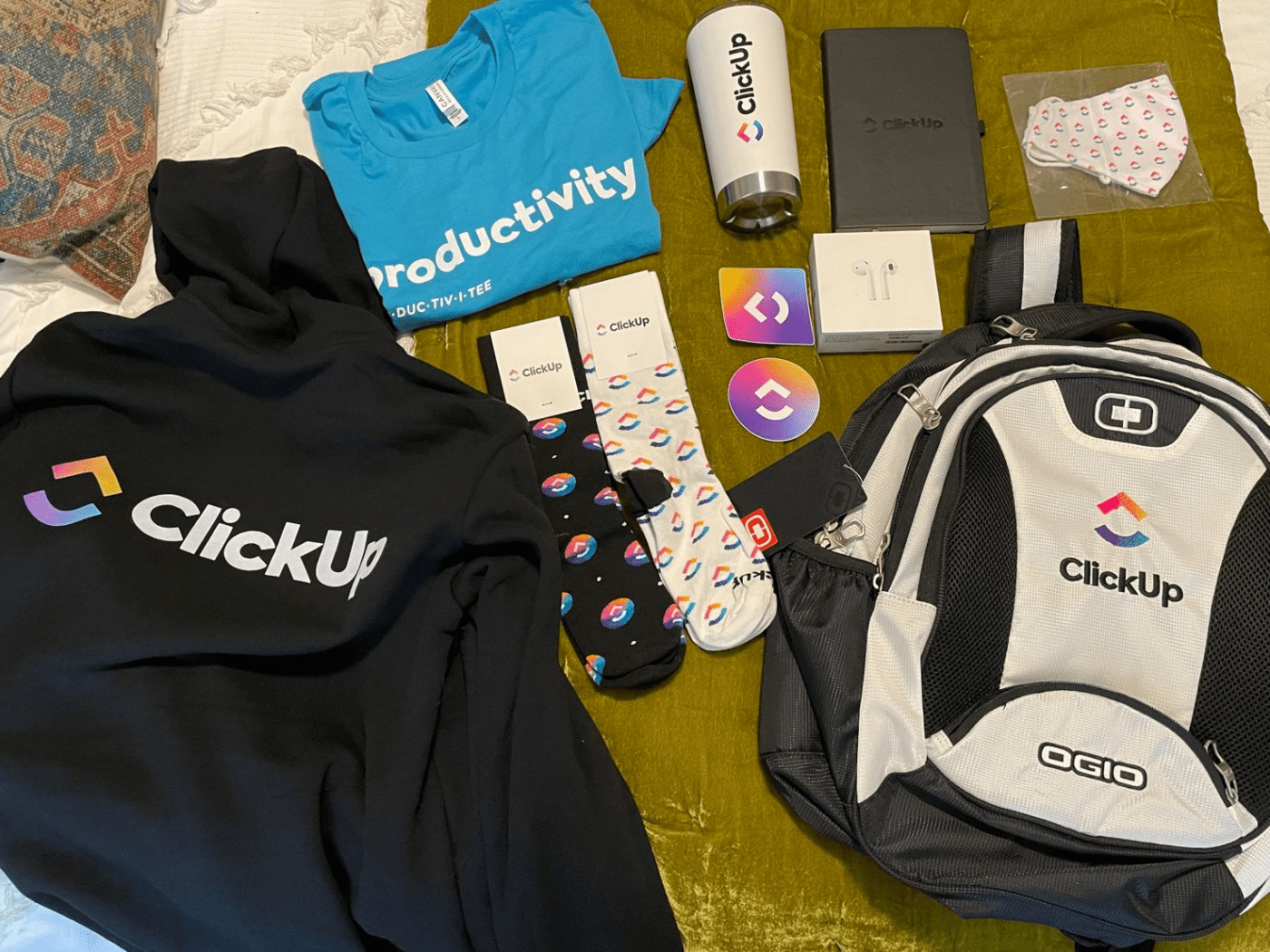
حقيبة غنيمة الترحيب من ClickUp عبر جيسون سكوفيل ، مسؤول توظيف الإيرادات في ClickUp
_ بمجرد تعيين الموظفين الجدد، يتم إرسال مجموعة أدوات ترحيبية لهم تتضمن كتيبات وبطاقات ومخطط مكتبي ورسالة ترحيبية وشوكولاتة لبدء رحلتهم بشيء حلو

مانيش شارما صندوق المتبرعين
مثال 3: أنشئ موضوعًا طريفًا وممتعًا وغنيًا بالمعلومات دليل الموظف #### المزايا
- يُظهر ثقافة الشركة الإيجابية
- يجعل تعلم معلومات جديدة أمرًا ممتعًا
- يضفي طابعًا إنسانيًا على تجربة التعلم (ستبدو أكثر إنسانية في التحدث مع البشر)
- يساعد الموظفين الجدد على الشعور بمزيد من الاسترخاء والراحة في بيئة العمل الجديدة
- يمنح الموظفين الجدد فرصة للاطلاع على سياسات الشركة
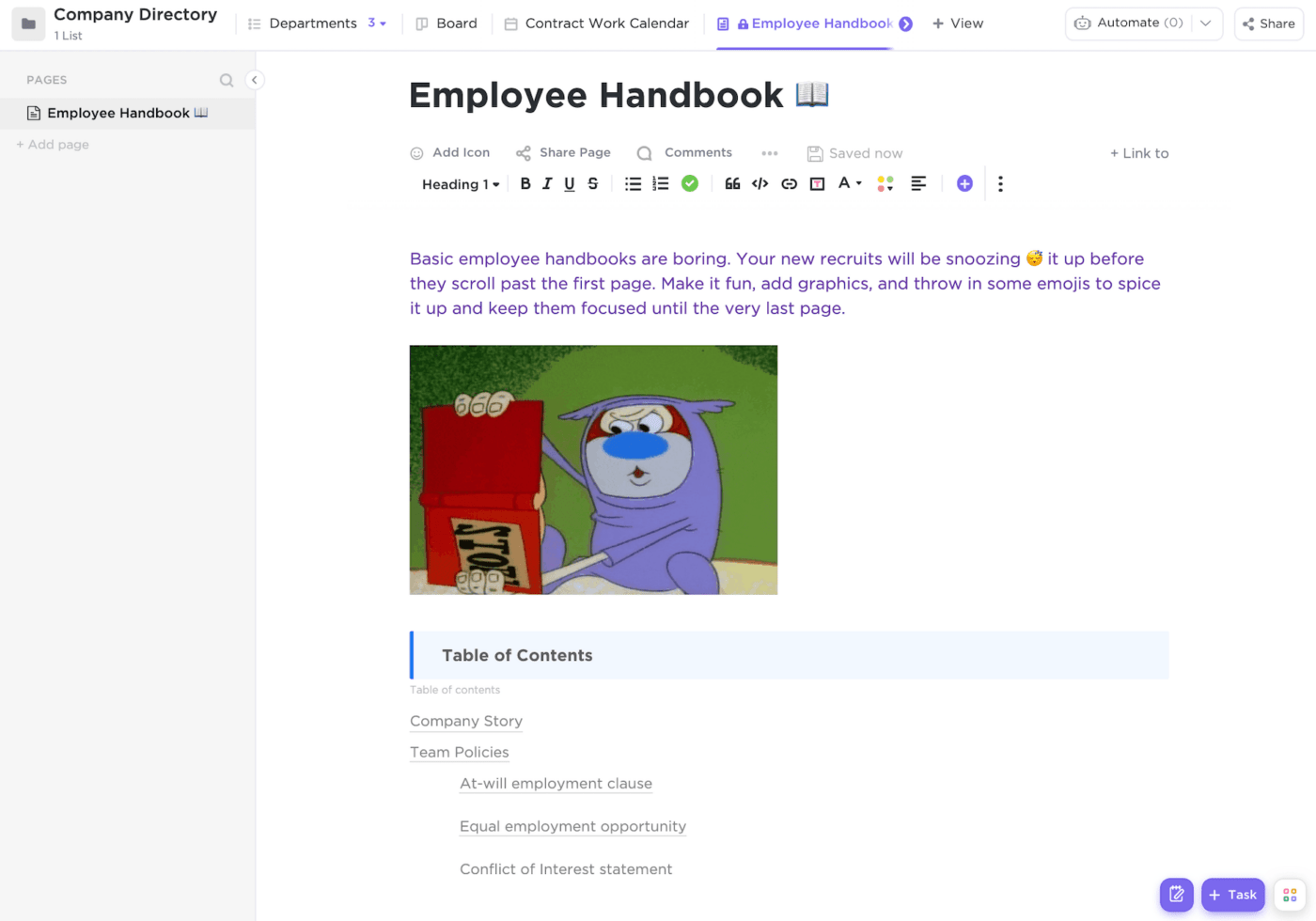
قالب دليل الموظف ClickUp
كيف يقوم الآخرون بذلك
_ قد يكون بدء وظيفة جديدة أمراً مرهقاً، لذا فإن الكتيب المضحك يساعد على تخفيف توتر اليوم الأول وإظهار ثقافة شركتنا. نحن نريد أن يفهم الموظفون الجدد أننا نحب أن نمرح بينما نحدد لهم التوقعات
لجعل التعلم أكثر متعة، أنشأنا كتيباً للموظفين مليئاً بالفكاهة المضحكة والمعلومات المفيدة لمساعدة الموظفين الجدد على التأقلم مع دورهم، والعمل على توقعات الفريق والإدارة على طول الطريق. ووفقًا لنتائج استطلاع الرأي الذي أجريناه بعد التعيين، فإن الكتيبات حققت نجاحًا كبيرًا! ويذكرها العديد من الموظفين على أنها الجزء المفضل لديهم من العملية. _

سكوت ليبرمان هبوط النقود
📌نصيحة محترف
لجعل الخطوات الأولى من التأهيل أسهل بالنسبة للموظفين الجدد، تحتاج كل شركة إلى كتيب للموظفين. ولجعل المهمة المعقدة لإنشاء هذا الكتيب أكثر بساطة، استفد من قالب كتيب دليل الموظف من ClickUp!
كتيب كتيب الموظف سهل التحرير والتفصيل من ClickUp نموذج يساعد مديري الموارد البشرية وقادة الشركات:
- تنظيم جميع الأقسام اللازمة لدليل الموظفين لديك
- تخصيص كل قسم مع سياسات شركتك وعملية التأهيل الخاصة بشركتك
- تعاونوا فيدليل الموظف الخاص بك مع التحرير في الوقت الفعلي والمشاركة السهلة
- توفير موارد احترافية لمشاركتها مع موظفيك
 قم بتنزيل نموذج دليل الموظف الخاص ب ClickUp
قم بتنزيل نموذج دليل الموظف الخاص ب ClickUp
مثال 4: مشاركة مقطع فيديو "ترحيبي" من قادة شركتك
الفوائد
- إنشاء علاقة أقوى بين القادة والموظفين
- يساعد الموظفين الجدد على الشعور بالترحيب والتواصل مع قادة شركتهم
- يمنح الموظفين الجدد فرصة لرؤية قادتهم وسماعهم بدلاً من قراءة بريد إلكتروني (يضفي طابعًا إنسانيًا على التجربة)
- يخلق الحماس حول الشركة ودورهم في المؤسسة
كيف يقوم الآخرون بذلك
- قام زيب، رئيسنا التنفيذي ومؤسس شركتنا، بإنشاء مقطع فيديو رائع لموظفينا الجدد لمشاهدته في يومهم الأول. ويتعلق الأمر كله بجعلهم متحمسين للوظيفة التي هم على وشك القيام بها والشركة التي يعملون بها. إنه يشجعهم على السماح لأنفسهم بالنمو والتعلم والقيام بعمل رائع في كل ما جاءوا إلى ClickUp للقيام به!

كاثرين ريكيا، كليك أب
لا يخفى على أحد أن تأهيل الموظفين الجدد أمر بالغ الأهمية ويعزز مشاركة الموظفين وشعورهم بالانتماء. لقد أدركنا أن أحد أكبر العوائق التي تحول دون التهيئة الرائعة للموظفين الجدد هو عدم معرفة الموظفين الجدد بما يمكن توقعه، مما يجلب نوعًا معينًا من القلق الذي يمكن أن يعكر صفو العملية برمتها. ومع وضع ذلك في الاعتبار، قررنا إدراج إجراءات لتقليل الضغط في اليوم الأول
_ لذا، في Talentify، ندعو القادة وفرق العمل إلى تسجيل مقطع فيديو قصير للتعريف بأنفسهم والتحدث عن الشركة والوظيفة وإرساله للزميل الجديد قبل بضعة أيام من بدء عملية التعيين.>
لقد اكتشفنا أن موظفينا الجدد يأتون للعملية بثقة أكبر بكثير، ويعرفون ما يمكن توقعه، ومتحمسون بشكل لا يصدق

ريكاردو فون جرول تالنتفاي
مثال 5: تقسيم عملية التأهيل إلى مراحل
الفوائد
- يمنح أعضاء الفريق الجدد الدعم ويقيهم من الحمل الزائد للمعلومات
- يحسن التعلم ويمنح الموظفين الجدد الاهتمام الذي يحتاجونه في الوقت المناسب
- يسمح للموظفين الجدد بالتركيز على عدد قليل من الأهداف المتعلقة بالتدريب في كل مرة
كيف يقسِّم ClickUp عملية التأهيل
إن عملية تأهيل الموظفين في ClickUp مقسمة إلى ثلاث مراحل: التأهيل المسبق، والتوجيه، والتدريب الخاص بالأدوار.
ويقود مرحلة ما قبل التهيئة فريق عمليات الأفراد، الذي يضمن توقيع المستندات القانونية واستكمال جميع المهام الإدارية قبل يوم التوجيه.
يدير مرحلة التوجيه فريق تطوير المواهب الذي يزود الموظفين الجدد بمعلومات عامة عن الشركة والعمليات والسياسات لضمان معرفتهم بما يجب أن يعملوا عليه وإعدادهم للنجاح.
التدريب الخاص بالأدوار هو المرحلة الأخيرة من عملية التهيئة الأولية. وهي المرحلة التي يتم فيها تعريف أعضاء الفريق الجدد بالمهام والمعلومات الخاصة بأدوارهم وفرقهم.
_تجعل الأسابيع القليلة المركزة حقًا والتي تسمح للموظف الجديد بالتأقلم بسهولة مع دوره بدلاً من الشعور بالإرهاق من كل ما يُلقى عليه!

كاثرين ريكيا، كليك أب
كيف يقوم الآخرون بذلك
ينقسم إطار عمل Proofhub لتأهيل الموظفين إلى ثلاث مراحل. تُخصص الأسابيع الثلاثة الأولى من التأهيل لمساعدة الموظف والمؤسسة على التعرف على بعضهما البعض.
كما يتم تزويد الموظفين الجدد بسلسلة من مقاطع الفيديو التعريفية والعروض التوضيحية للمنتجات لإعطاء الموظفين الجدد فهماً أساسياً للشركة ومنتجاتنا. وتتضمن المرحلة الثانية من التأهيل مجموعة من المهام الأساسية التي يتعين على الموظف الجديد إكمالها لقياس كفاءته في العمل وإتقان مهاراته أيضاً.
وتتيح المرحلة الأخيرة للموظفين الجدد المساهمة بوجهات نظرهم الفريدة في المهام وخلال الجلسات الاستراتيجية الأسبوعية.
لقد أتاح تقسيم عملية التأهيل إلى مراحل وتقديم مهام ومعلومات محددة للموظفين الجدد استيعاب المعلومات الجديدة بشكل أكثر فعالية، والتواصل مع فرقهم، والشعور بالراحة في بيئة جديدة

فارتيكا كاشياب بروفهاب
📌نصيحة محترف
هل موظفوك الجدد موظفون عن بُعد أو موظفون مختلطون؟
قم برقمنة برنامج التأهيل الخاص بك في ClickUp وقم بإدارة تأهيل الموظفين الجدد من أي مكان تتواجد فيه! يتيح لك ClickUp إنشاء مهام التأهيل بسهولة، وتعيين المشاريع للموظف الجديد، وحتى إنشاء حالات مخصصة لإظهار كل مرحلة من مراحل التعيين الجديدة بوضوح. استخدم هذا البرنامج الجاهز للاستخدام والقابل للتعديل قالب تأهيل الموظف الجديد عن بُعد للبدء الآن!
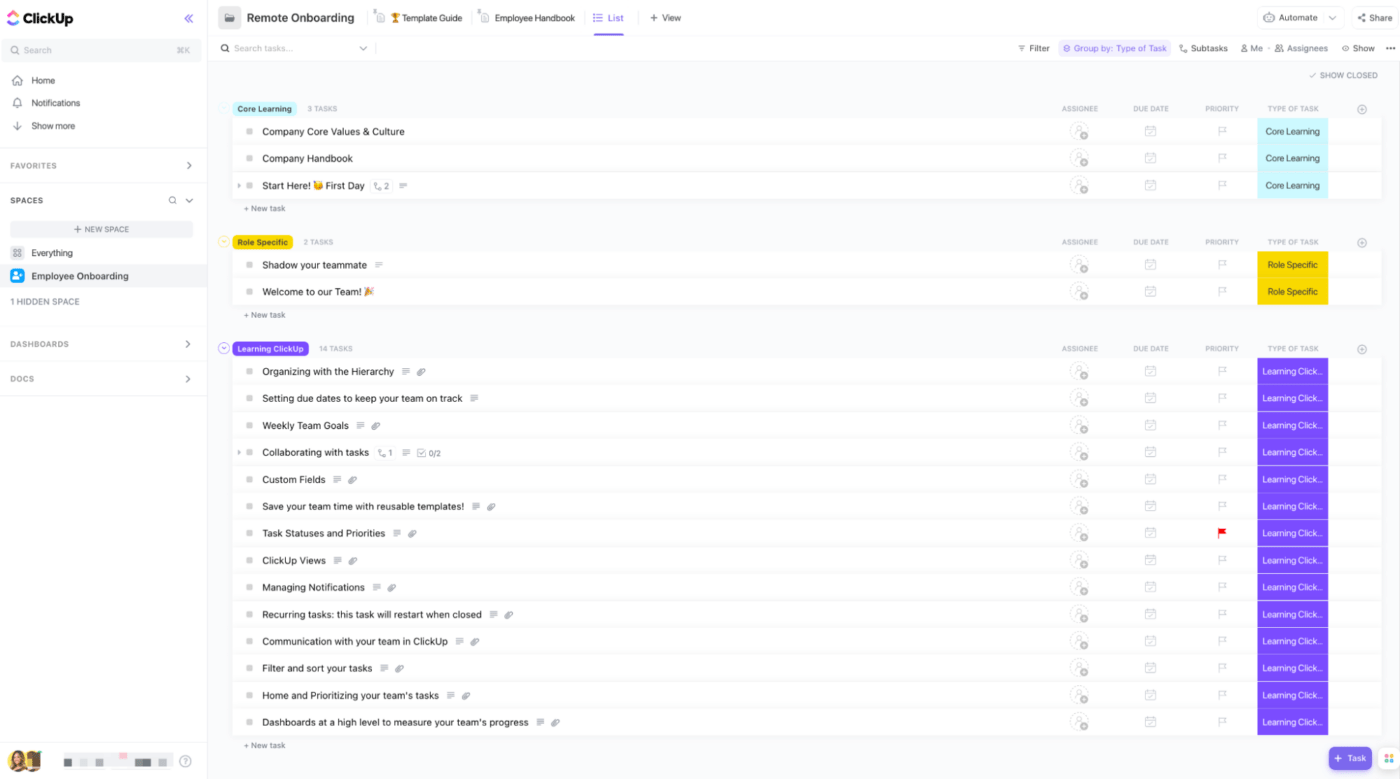 تنزيل قالب تأهيل الموظفين عن بُعد من ClickUp
تنزيل قالب تأهيل الموظفين عن بُعد من ClickUp
مثال 6: تعيين مشروع أولي موجز لدراسة أسلوب العمل
الفوائد
- يساعد المديرين وقادة الشركة في الحصول على نظرة ثاقبة عن كل عضو جديد في الفريقأساليب العمل وتفضيلات التعلم
- يساعد المدراء على تحديد نقاط القوة والدوافع ومستوى المهارات لدى المديرين
- يتيح الفرصة للمديرين للتحدث مع أعضاء الفريق الجدد للحصول على تعليقاتهم حول المشروع وسير العمل، بالإضافة إلى التعرف على ما يستمتع به عضو الفريق الجديد والعكس صحيح
📌نصيحة للمحترفين
كل شخص لديه نقاط قوة مختلفة، وتحديات مختلفة، و أساليب مختلفة في العمل والتعلم -هذه الاختلافات هي ما يجعل كل شخص فريدًا وقيِّمًا للمؤسسة. قم ببناء أفضل تأهيل للموظفين يناسب كل فرد من خلال دعم أساليب التعلم والعمل الخاصة بهم في العمل وباستخدام أدوات الموارد البشرية مع إمكانيات التخصيص للسماح لكل عضو من أعضاء الفريق بتخصيص مساحة العمل وسير العمل بما يتناسب مع احتياجاته وتفضيلاته على أفضل وجه. سيؤدي ذلك إلى تمكين كل موظف جديد من بناء سير عمل يمكّنه من العمل بأكبر قدر ممكن من الكفاءة والفعالية، وهذا بدوره سيكون مكسبًا لفريقك أيضًا. 🧠✨
كيف يقوم الآخرون بذلك
لقد أنشأنا نظامًا موحدًا جدًا لإعداد الموظفين الذين نستخدمه لجميع موظفينا على مدار العام ونصف العام الماضيين. عملية التأهيل هذه تجعل من السهل البدء والبقاء على المسار الصحيح
الخطوات:
1. تقديم إحاطات أسبوعية بشكل شخصي أو عبر الهاتف حول ما يجري في الشركة
2. تعيين أول مشروع لهم لفهم أسلوب عملهم - شيء بسيط مثل حملة بريد إلكتروني أو إعادة تصميم موقع إلكتروني يمكن إنجازه في أسبوع أو أسبوعين يساعدنا على التعرف على أسلوب عملهم
3. نتركهم طلقاء للعمل على مشاريعهم الخاصة _نمنحهم استقلالية كاملة فيما يقومون به، والمدة التي يستغرقها العمل ومتى يقدمون عملهم. كما نحرص أيضًا على إبقائهم على اطلاع دائم طوال العملية حتى يعرفوا ما إذا كانت هناك أي تغييرات على
التسليمات__
والمتطلبات._
مع هذا النظام التأهيلي، شهدنا ارتفاع معدلات الاحتفاظ السنوية لدينا بنسبة 28%، مما ساعدنا بشكل كبير في التخفيف من آثار الاستقالة الكبرى

دان باريت الأفضلية الاجتماعية
مثال 7: أرسل رسالة ترحيب صادقة مكتوبة بخط اليد أو رسالة ترحيب رقمية
الفوائد
- بناء التواصل والألفة بين أعضاء الفريق والمديرين
- إضفاء الطابع الإنساني على عملية التأهيل
- يساعد الموظفين الجدد على الشعور بأنهم مرئيون ومسموعون ومقدرون
- اللفتات البسيطة يمكن أن تترك انطباعاً دائماً وتحسن من شعور الموظفين
📌نصيحة احترافية
في حين أن كتابة خطاب ترحيب لكل موظف قد يستغرق الكثير من الوقت، إلا أن العائد على الاستثمار لا يقدر بثمن حقًا. فهي لا تخلق بداية إيجابية مع موظفيك فحسب، بل تساعدهم أيضًا على الشعور بالتقدير والتحفيز لتقديم أفضل ما لديهم في العمل.
إليك ما يلي أفضل 30 رسالة ترحيب للموظفين الجدد لمساعدتك في الحصول على أفكار حول كيفية بدء رسالتك. وعندما تكون مستعدًا لكتابة رسالتك المخصصة، استخدم ClickUp Docs, حيث يمكنك تخصيص رسالتك عن طريق تغيير ألوان الخط وإضافة الصور وتضمين مقاطع الفيديو والمزيد! بمجرد إعداده لمشاركته مع موظفك الجديد، ما عليك سوى إرسال رابط عام أو خاص.
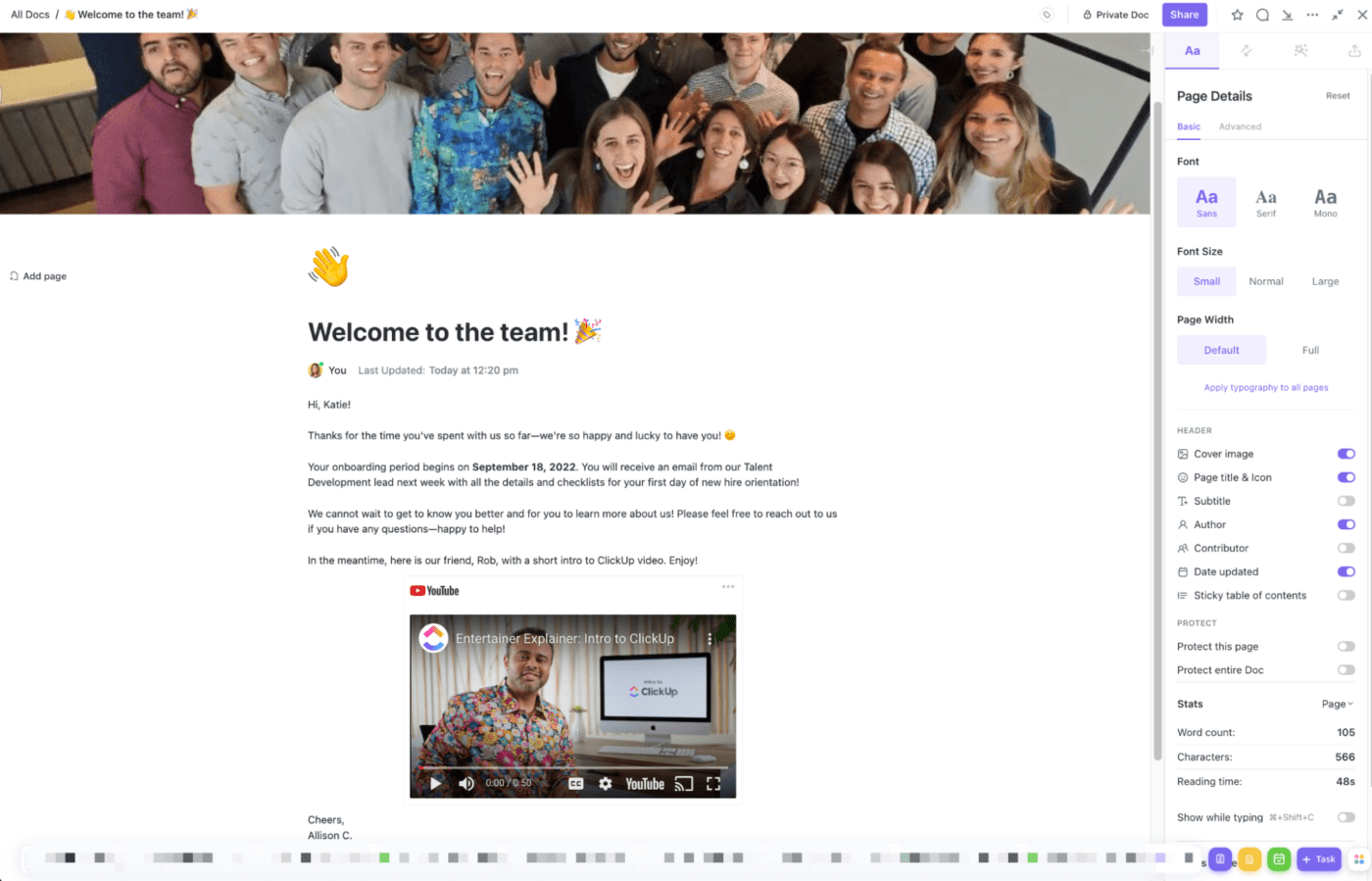
أنشئ رسائل ترحيب مخصصة في ClickUp Docs وشاركها بشكل خاص مع أعضاء فريقك الجدد
كيف يقوم الآخرون بذلك
_ نعتقد أن عملية التأهيل يجب أن تكون تجربة شاملة ومستمرة، وليست مجرد حدث لمرة واحدة. جزء أساسي من برنامج التأهيل لدينا هو خطاب الترحيب المكتوب بخط اليد. يتلقى كل موظف جديد رسالة شخصية من مديره في يومه الأول، يرحب فيها بانضمامه إلى الفريق ويسلط الضوء على بعض الأشياء التي يمكن أن يتطلع إليها في منصبه الجديد
_ لقد وجدنا أن هذه اللفتة البسيطة تساعد على تهيئة بيئة عمل دافئة وداعمة وتتيح لأعضاء فريقنا معرفة أنهم موضع تقدير منذ البداية. بالإضافة إلى ذلك، إنها مجرد لمسة لطيفة تجعل الناس يشعرون بأنهم مميزون!

ريك إلمور ببساطة لاحظت
مثال 8: مشاركة مقاطع الفيديو التي تلوح في الأفق أو مقاطع الفيديو لشرح معقد
الفوائد
- يمكن للموظفين مشاهدتها في وقتهم الخاص ويمكنهم إعادة مشاهدتها عدة مرات حسب الحاجة
- إنها مفيدة للجميع، بما في ذلك الموظفين الذين يتعلمون بصريًا
- مقاطع الفيديو المسجلة مفيدة عند شرح العملية والأفكار المعقدة
- يمكن لأعضاء الفريق الرد على مقاطع فيديو Loom من خلال إضافة ردود أفعال بالرموز التعبيرية أو كتابة تعليق

عبر Loom
_لوم يمنح شركتنا ميزة تسجيل شاشة مشتركة لشرح المهام البسيطة والعمليات والمعلومات المطلوبة مع إظهار وجه الشخص الذي يتحدث وتسجيل صوته لجعل الأمر أكثر خصوصية وجاذبية للموظف الجديد
باستخدام مقاطع فيديو Loom، يمكننا تقسيم المعلومات المهمة إلى مقاطع فيديو مدتها دقيقتان كحد أقصى خاصة بكل مهمة على حدة، مما يسهل على المرشحين العودة إليها وإعادة مشاهدتها عند الحاجة. كما يسمح أيضًا بتسريع الفيديو ليتم تعديله حسب ما يفضله المستمع.

جوردان فابل دورة معتمدة
📌نصيحة محترف
قم بتسجيل وإرسال وتشغيل مقطع فيديو كل ذلك ضمن مهمة ClickUp. التقط على الفور شاشتك بالكامل، ونافذة التطبيق، وعلامة تبويب المتصفح، وأضف صوتك وسجله أثناء إنشاء فيديو إرشادي. عند الانتهاء من التسجيل، يمكنك ببساطة وعلى الفور مشاركة مقطع الفيديو الخاص بك مع فريقك أو أي موظف جديد عبر رابط قابل للمشاركة، أو إسقاط الرابط داخل مهمة ClickUp.
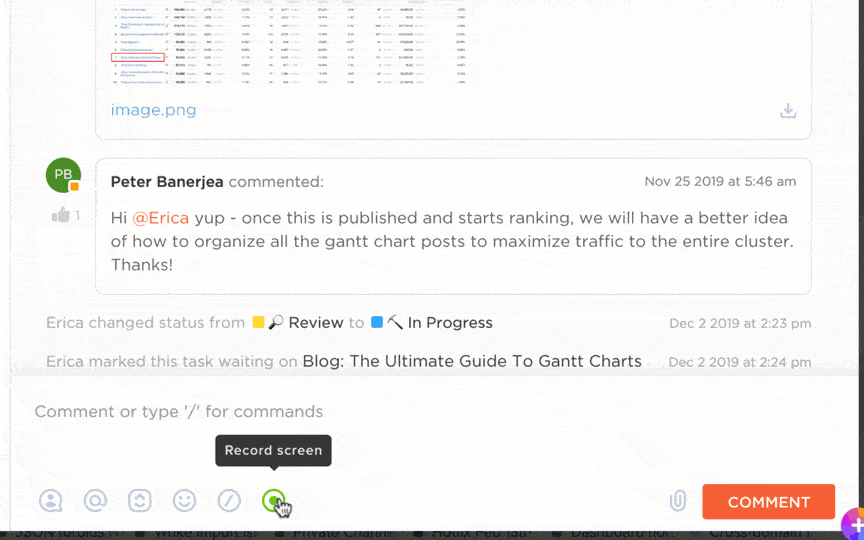
شارك تسجيلات الشاشة لتوصيل رسالتك بدقة دون الحاجة إلى سلسلة رسائل بريد إلكتروني أو اجتماع شخصي
مثال 9: إنشاء أدلة المستخدم للمديرين وجميع أعضاء الفريق
الفوائد
- يمكن لأعضاء الفريق معرفة المزيد عن عمل كل زميل وأساليب التواصل والتعلم الخاصة بكل زميل
- يمنح الموظفين نظرة ثاقبة حول كيفية التعامل مع الشخص والمواقف في العمل
- فهم كيف يمكن أن يساعد فهم تفضيلات كل عضو من أعضاء الفريق في تماسك الفريق وتحسين التواصل والتعاون بين أعضاء الفريق
- معرفة المزيد عن بعضهم البعض وعن الحياة خارج العمل يمكن أن يساعد في تقريب الفرق وإضفاء الطابع الإنساني على مكان العمل
📌نصيحة احترافية
أنشئ مستند "العمل معي" في ClickUp وشاركه مع أعضاء فريقك. قم بتضمين معلومات مفيدة مثل نوع الشخصية، وأسلوب الإدارة والفلسفات، وأساليب التواصل، والأهداف، والهوايات، والمشاكل التي تزعجك! جرّب ClickUp Docs
_ نطلب من جميع الموظفين الجدد إنشاء "دليل مستخدم" لأنفسهم، وهو عبارة عن وثيقة موجزة تتضمن نبذة عن نشأتهم ورحلتهم المهنية وأساليبهم في التعلم وتفضيلاتهم في التواصل وهواياتهم. ويمكن لهؤلاء الموظفين الجدد أيضًا الوصول إلى أدلة المستخدم الخاصة بكل موظف آخر في المؤسسة
إنها طريقة رائعة لإضفاء الطابع الإنساني على الزملاء، خاصة في بيئة العمل الموزعة، وتساعد الموظفين الجدد على التأقلم بسرعة مع زملائهم في الفريق وثقافة الشركة

سارة سميث زيتون
مثال 10: إنشاء برنامج الأصدقاء على متن الطائرة
الفوائد
- يوفر مستوى آخر من الدعم في العمل
- يساعد على تعزيز ثقافة الشركة
- يمكن للموظفين الجدد مشاركة تجربة التأهيل معًا
- يحصل الموظفون على شريك للمساءلة للحفاظ على تحفيزهم
كيف يقوم الآخرون بذلك
_ من حوافز التهيئة التي تنجح حقًا في الحياة الواقعية هو برنامج الأصدقاء المهيئين. يتضمن هذا البرنامج تعيين كل موظف جديد موظفًا ذا خبرة لرعايته في الأسابيع القليلة الأولى في الوظيفة الجديدة
يعمل رفيق التهيئة بمثابة نقطة الاتصال الأولى، حيث يقوم بمساعدة الموظفين الجدد وإرشادهم. فهم يقدمون الدعم والتبصير بثقافة الشركة ويجيبون عن الأسئلة. ويقومون بتسهيل عملية الإعداد، مما يجعل تجربة تغيير الوظيفة غير مؤلمة قدر الإمكان

نينا باتشكا سيرتي الذاتية المثالية
مثال 11: تقديم برامج إرشادية واجتماعات فردية وورش عمل تعليمية
الفوائد
- السماح للموظفين بالنمو بنسبة 1% كل يوم، وتحديد أهداف SMART، وإنشاء مسارات وظيفية واضحة
- يمكن لأعضاء الفريق الذين لديهم الحافز للنمو الوظيفي العمل على الخطوات الصحيحة للوصول إلى هناك
- يعزز بيئة تعليمية إيجابية ويساعد على صقل المهارات الشخصية والصلبة
- يسمح لأعضاء الفريق بتصور مستقبلهم مع الشركة وتحسين الاحتفاظ بالموظفين #### كيف يقوم الآخرون بذلك
لدمج الموظفين الجدد والكشف عن القدرات القوية لـ ClickUp، يستضيف فريق تمكين المنتجات والأنظمة لدينا 4 أيام من التعلم من خلال المحاضرات والتجارب العملية وقصص العملاء والمناقشات الجماعية في برنامج يسمى مختبر المنتجات.
وخلال هذه الجلسات التفاعلية نقوم بإشراك أعضاء الطاقم الجديد مع شخصيات للتفكير بشكل متعاطف مع عملائنا وتطبيقنا للتفكير بشكل نقدي حول كيفية حل منصتنا لتحديات العملاء.
لقد سمعنا مرارًا وتكرارًا عن مدى كون هذه التجربة هي اللحظة التي تنبه فيها المنتج حقًا لأعضاء الطاقم. 💡

ماشاري ووكر، ClickUp
_ لقد أدركنا أن مرحلة الإرشاد هذه تمكن موظفينا الجدد من الاستقرار بشكل أسرع، والتكيف بسرعة مع ثقافتنا وعملياتنا، كما أننا نوفر لهم البيئة والأدوات ونظام الدعم المناسبين لكي يتفوقوا في أدوارهم منذ البداية
_ وهذا يتيح لنا التواصل مع موظفينا الجدد في أقرب وقت ممكن في رحلة التوظيف، وتطوير العلاقات معهم قبل أن يبدأوا العمل لدينا، والحصول على فهم أفضل لنقاط القوة والضعف لدى كل موظف

دان باريت المهووسون بـ Adwords
مثال 12: اطلب ملاحظات مستمرة وصادقة
الفوائد
- يعطي المنظمة والقادة نظرة ثاقبة حول نجاح برنامج التأهيل
- يسمح للمديرين بالعمل على مجالات الفرص المتاحة وتحسين العملية باستمرار
- يزود القادة بأفكار لأحداث الفريق القادمة ويساعدهم على فهم العمل من وجهة نظر موظفيهم
- يحسن الرضا الوظيفي العام، ومشاركة الموظفين، ومعدلات الاحتفاظ بالموظفين
- يسمح للموظفين بالنمو مع نمو أعمالك المتنامية
- يعامل الموظفين كمساهمين متساوين في العمل
كيف يقوم الآخرون بذلك
إن التطوير المهني الذي يتمحور حول السلامة النفسية والتعاطف والصراحة الجذرية هي بعض المبادرات المهمة التي حققت نجاحاً هائلاً
/ href/ _https://clickup.com/blog/employee-engagement-software// عززت مشاركة الموظفين /%href/_
في ClickUp._
عندما يشعر الموظفون حقًا أنهم جزء من شيء أكبر من أنفسهم، ينعكس ذلك داخل الشركة. عندما يشعرون بأن أفكارهم وأفكارهم وملاحظاتهم تحظى بالتقدير، فإنهم يحرصون على تقديم الحلول. عندما يدرك جميع الأشخاص، بغض النظر عن دورهم، أنهم يساهمون في السلامة النفسية للمؤسسة، فإن جميع الأشخاص يعملون بجد للحفاظ عليها._

ماندي ميخائيل، كليك أب
بهذا نختتم هذه الجولة من أمثلة تأهيل الموظفين! حان الوقت الآن لإعطائك نصائح حول كيفية إعداد وتتبع برنامجك وجهودك في التأهيل بفعالية. 🎯
نصائح سريعة لتحديد الأهداف وتتبع النجاحات
آمل أن نكون قد ساعدنا الآن في إثارة بعض الأفكار الرائعة لبرنامجك التأهيلي! ولكن لضمان نجاحه، ستحتاج إلى ما يلي تحديد الأهداف وقياس التقدم الذي تحرزه . إليك نصائحنا لتحديد الأهداف وتتبع النجاح:
- استخدم أدوات إدارة المشاريع مع ميزات تتبع الأهداف لمساعدتك على تتبع تقدمك بفعالية وتحديد العوائق وقياس نجاح برنامجك.
- ضع أهدافًا ذكية. ويشمل ذلك كلاً منالأهداف قصيرة الأجل وطويلة الأجل, وتحتاج إلى تحديد أهدافك قبل بدء برنامج التأهيل الخاص بك.
- ضع أهدافًا واضحة لتتبع المكاسب. قم بتوثيق أهدافك وإدارتها في ClickUp وربطها بمهامك داخل المنصة لتتبع أكثر فعالية.
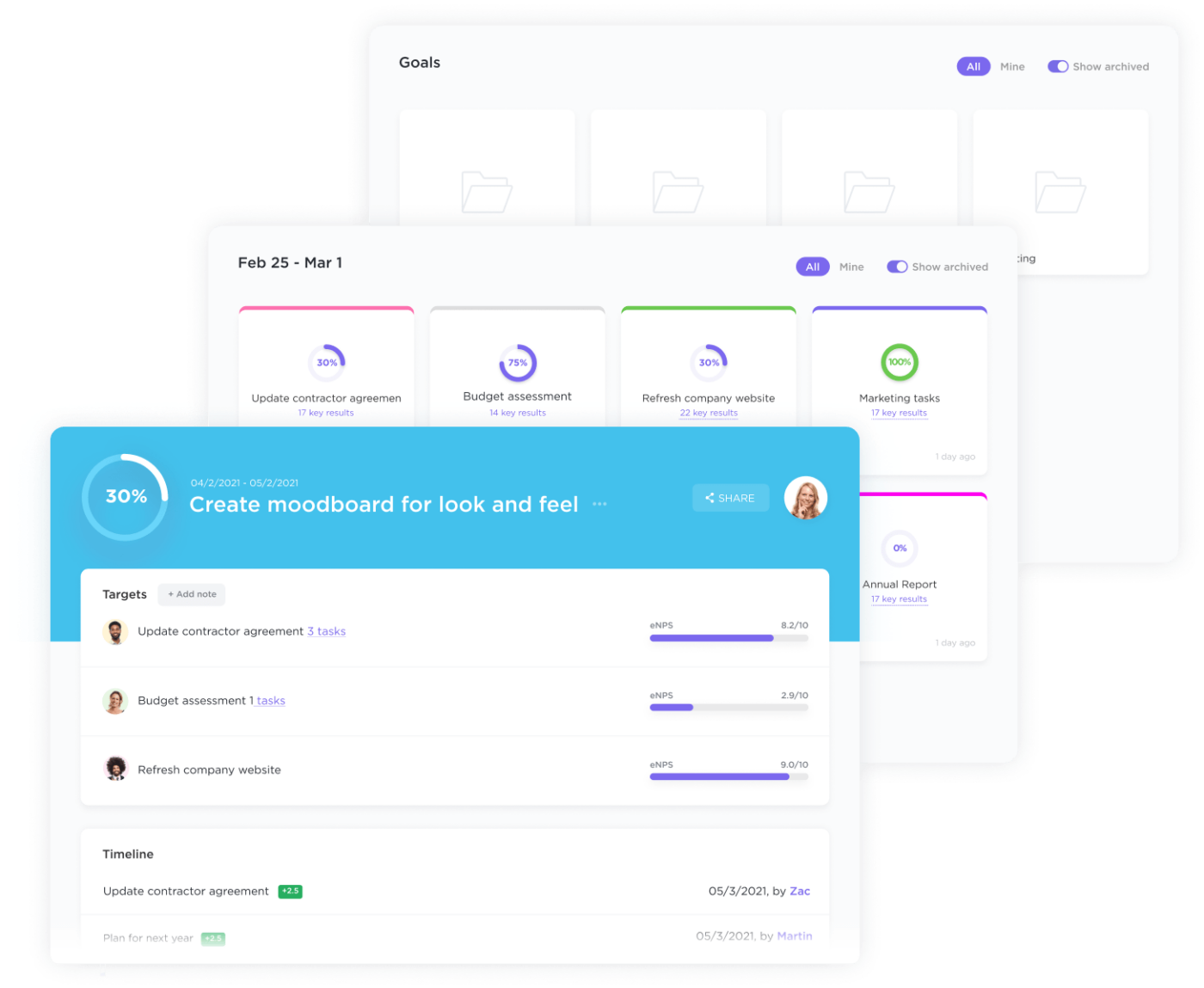
ابقَ على المسار الصحيح لتحقيق أهدافك من خلال جداول زمنية واضحة وأهداف قابلة للقياس وتتبع التقدم التلقائي
- نظم أهدافك باستخدام المجلدات. أنشئ مجلدات لتتبع دورات العدو السريع، و OKRs، وبطاقات الأداء الأسبوعية للموظفين، وأي عدد من أهداف الفريق المهمة
- استخدم قالب OKR وأهداف الشركة في ClickUp . مساعدة فريقك على البدء وتوفير نهج منظم لتتبع الأهداف
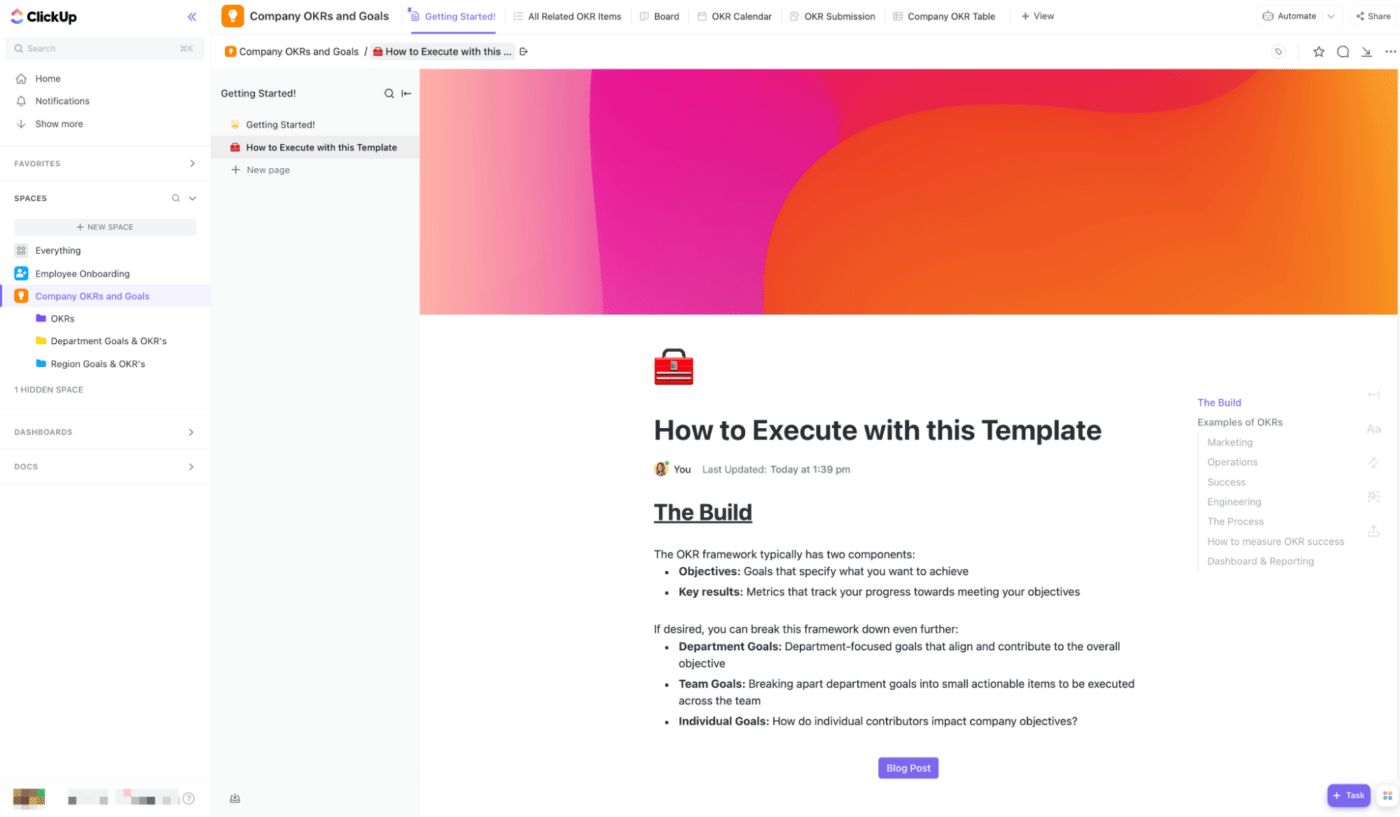 قم بتنزيل نموذج OKR والأهداف الخاصة بشركة ClickUp's ClickUp
قم بتنزيل نموذج OKR والأهداف الخاصة بشركة ClickUp's ClickUp
- أنشئ لوحة تحكم مخصصة في ClickUp. اجمع كل أعمالك معًا واحصل على نظرة عامة عالية المستوى على عملك واطلع على التفاصيل المهمة حول تقدم مبادراتك في لمحة سريعة
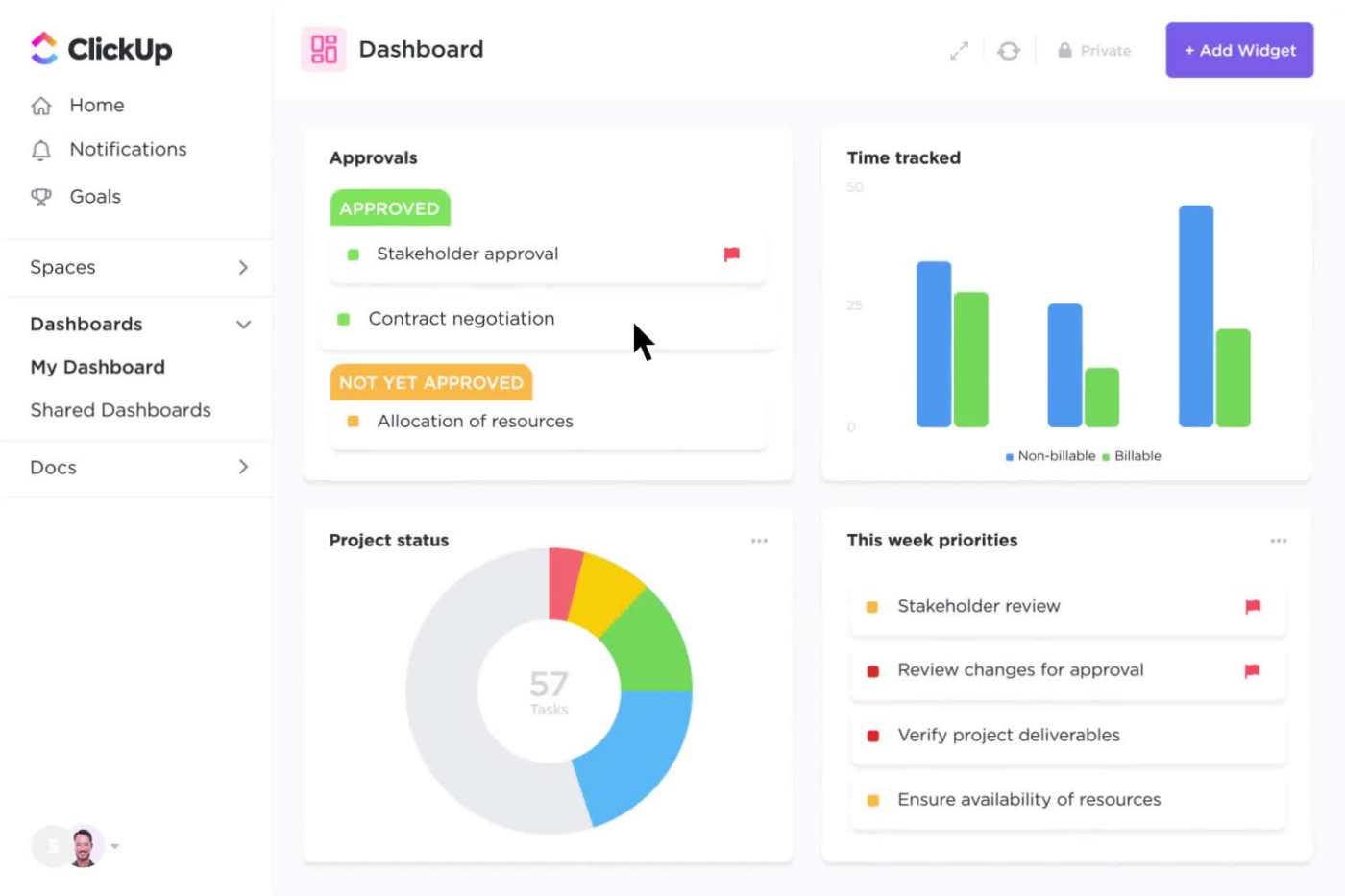
إنشاء لوحات معلومات مخصصة في ClickUp للحصول على نظرة عامة عالية المستوى لجميع أعمالك
- استخدمميزة النماذج في ClickUp. إنشاء مخصصنماذج الملاحظات للموظفين الجدد لديك لإكمالها قبل وبعد التعيين. بمجرد إكمال النموذج وإرساله، سيقوم ClickUp تلقائيًا بإنشاء مهام من الردود، مما يتيح لك تتبع الملاحظات بسهولة، وربط المهمة بأهدافك، وإنشاءعناصر العمل لمساعدتك على تحسين تجربة تأهيل الموظفين باستمرار

قم بإنشاء نماذج مخصصة في ClickUp لالتقاط الملاحظات، وتحويل الردود على الاستبيان إلى مهام قابلة للتنفيذ - كل ذلك في مكان واحد
قم بإعداد موظفيك الجدد للنجاح وإتقان تجربة التأهيل
الموظفون هم أثمن الأصول التي يمكن أن تمتلكها الشركات. فخبراتهم وقدراتهم ومهاراتهم ومهاراتهم ومعارفهم ووجهات نظرهم هي التي تساعد في تشكيل مستقبل شركتك.
وبقدر ما يستثمرون وقتهم وطاقتهم في مؤسستك، افعل الشيء نفسه معهم وعاملهم كشركاء عمل. 🤝
استقطب أفضل المواهب واحتفظ بها من خلال فهم أهمية وجود برنامج تأهيلي قوي. جرّب بعض الأمثلة على برنامج تأهيل الموظفين الذي شاركه مهنيون آخرون في مختلف المجالات.
اخلق انطباعًا أوليًا قويًا، وقم ببناء علاقة مع الموظفين، وزودهم بجميع الأدوات التي يحتاجونها للنجاح في أدوارهم، واسمح لهم بالتطور في حياتهم المهنية داخل مؤسستك. ففي نهاية المطاف، هم أدرى بشؤون العمل.
هؤلاء الأشخاص هم أصوات ووجوه الشركة والعقل المدبر وراء العديد من حملاتك ومشاريعك ومبادراتك الرائعة.
لقد حان الوقت لإعدادهم في المستقبل واستخدام أداة عمل مصممة لمؤسستك بأكملها - قم بتنظيم وتحسين تعاون الفريق وتنظيم عملياتك وتبسيط برامج الإعداد وتطوير المواهب من خلال ClickUp . 🚀


